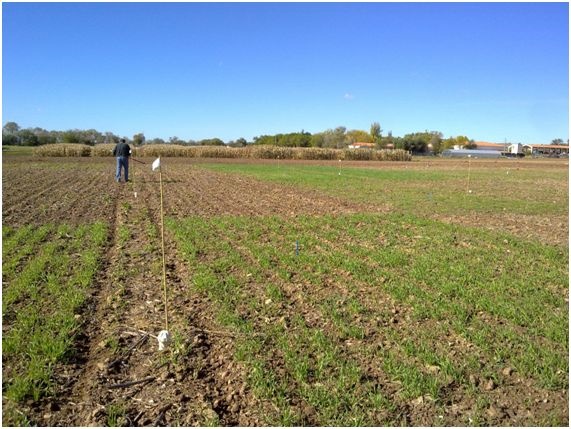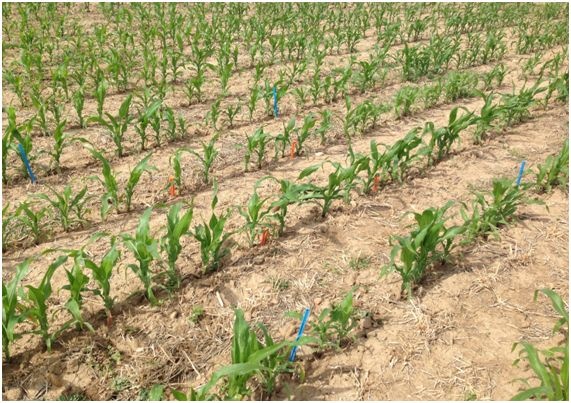Researchers from UPM and INIA suggest replacing fallow lands with cover crops in order to increase the levels of carbon and soil nitrogen. It also enhances its quality and mitigates nitrate leaching in an agricultural land.
A team of UPM researchers, in collaboration with the National Institute for Agricultural Research and Experimentation (INIA), has carried out a field experiment to determine the effects of replacing fallow lands in winter with a cover crop in a system of traditional tillage of summer crop rotation.
After collecting data for ten years, results indicate that such cover crops, which maintain the soil protected during winter months, reduce degradation and provide an extra organic matter after their completion.
The growing degradation of agricultural soils is an issue we have to deal with, especially in areas of traditional tillage that overused fertilization for years. Applying sustainable farming practices is an optimal solution and the research groups of UPM on Agricultural Systems (AgSystems) and Soil Quality and Environmental Application (CASAM) have implemented and adjusted these practices to the semiarid conditions of the center of Spain.

Líneas de maíz y restos vegetales en superficie de los cultivos cubierta sembrados en el periodo otoño-invierno. Ensayo de cultivos cubierta de larga duración (Finca La Chimenea, Aranjuez, Madrid).
The field experiment was conducted at La Chimenea Field Station (Madrid, Spain) from April 2006 to November 2016. The field experiment consisted of replacing both the traditional tillage with minimum tillage and maize monoculture with rotation maize using cover crops, thus replacing the fallow during winter periods.
The field experiment was divided into twelve plots where researchers applied three treatments in winter: two crops cover, barley (grass) and vetch (legume) and bare fallow as the control. The main crops were treated with herbicides (glyphosate) during April and sown with maize by the during summer months.
Irene García González, a member of the CASAM group and a researcher involved in this study, highlights that “after ten years of applying rotation crops, we observed how the continuous growth of biomass area, from cover crops and waste of maize crops, led to an increase of both carbon and nitrogen entry that are not release thanks to the rotation to minimum tillage”.
Researchers also observed an increase in organic carbon and nitrogen in the soil. This increase of carbon content contributed to a higher soil aggregate stability and, in addition, to a better soil water infiltration, which is more remarkable in the plots where barley was used as a cover crop.

Maize line crops and vegetable waste in the surfece of cover crops harvested during fall and winter. ield experiment of long-term cover crops (Finca La Chimenea, Madrid, Spain).
A study at four meters of depth allowed researchers to assess in detail the distribution of nitrogen in deeper layers of the soil. Minor levels of nitrogen were observed in the barley plots what it suggests the relevance of the roots to capture residual nitrogen compared to plots with bare soil.
As a result of the replacement of fallow with cover crops, researchers improved the quality of highly degraded soils due to the continuous traditional tillage. In addition, there was an increase of organic matter with the consequent increase of nutrients such as soil organic carbon and nitrogen.
Especially, the plot treated with barley as a cover crop improved the soil stability and water filtration, thus achieving water without contaminants in the supply of underground aquifers.
Miguel Quemada, the main researcher from the AgSystems group, “this type of studies helps improve the agricultural systems in Mediterranean irrigated areas of cool winters and dry summers. The data collected for ten years allowed researchers to better understand the benefits obtained after using cover crops and the tilling rotation”.
The project was funded by diverse Spanish R&D&I plans (AGL2008- 00163/AGR, AGL2011-24732, AGL2014-52310-R).
García-González, I., Hontoria, C., Gabriel, J. L., Alonso-Ayuso, M., Quemada, M. (2018). Cover crops to mitigate soil degradation and enhance soil functionality in irrigated land. Geoderma, 322, 81-88. DOI:10.1016/j.geoderma.2018.02.024.
García-González, I., Hontoria, C., Gabriel, J. L., Alonso-Ayuso, M., Quemada, M. (2018). Data supporting the cover crops benefits related to soil functionality in a 10-year cropping system. Data in Brief, 18, 1327-1333. DOI: 10.1016/j.dib.2018.04.029.